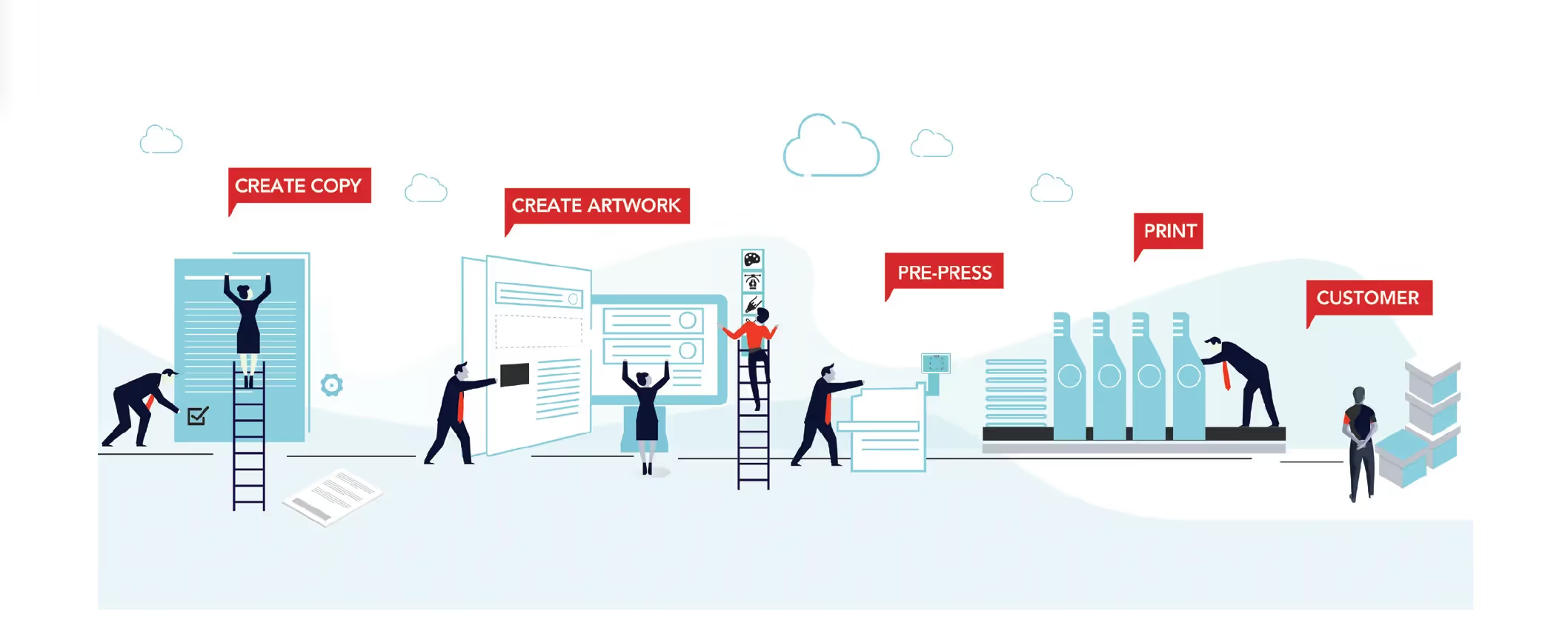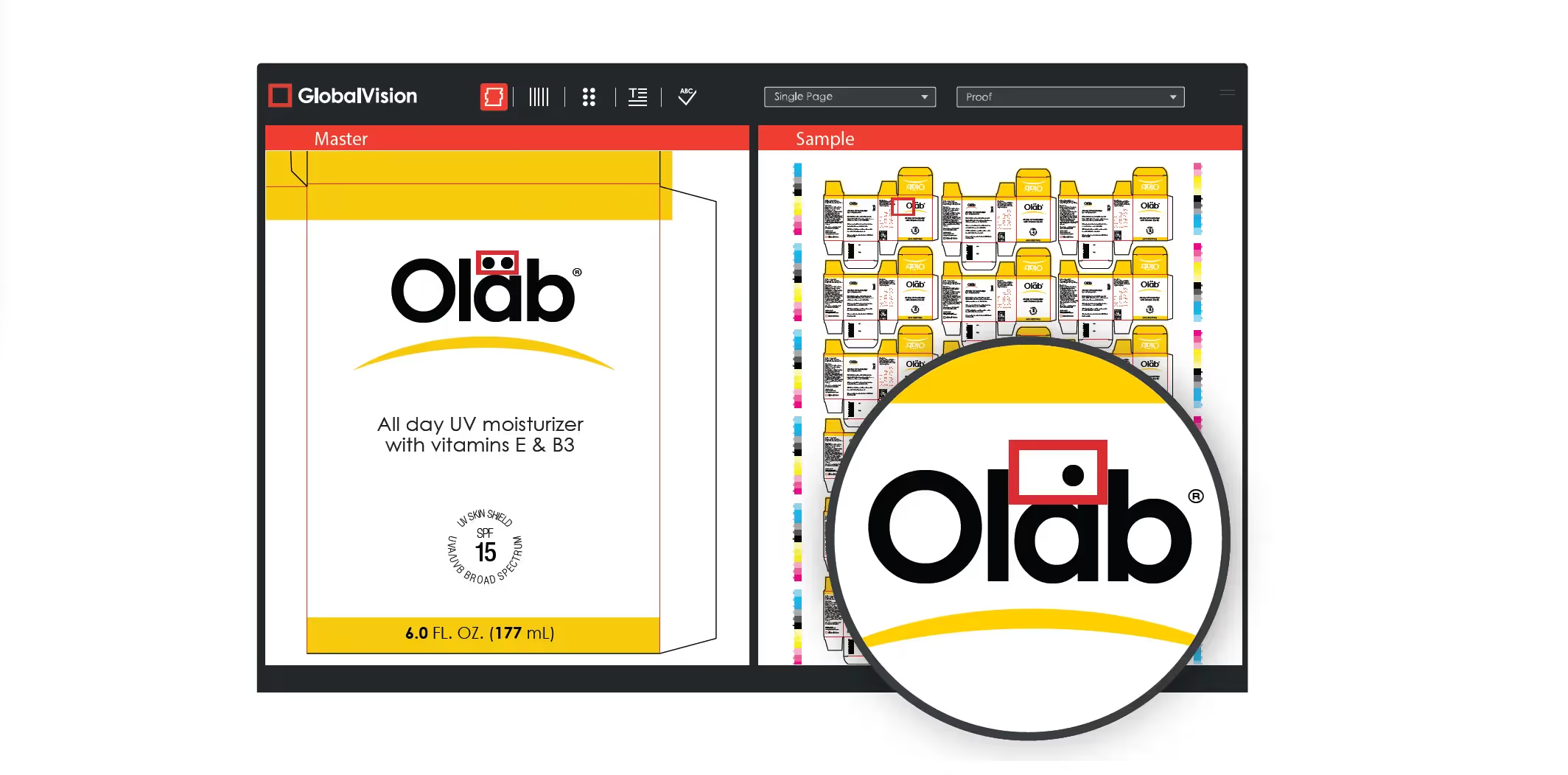Securing the Brand Packaging Workflow

Packaging Proofreading Requirements
The Food, Chemical, Cosmetic, and Pharmaceutical industries all define packaging quality differently. While the food industry is very concerned about printed color and not as concerned about broken type, the pharmaceutical industry uses very little color, but is very concerned about broken and missing type.
This paper discusses how to automate printed packaging quality control and the different techniques and systems that can be used in the packaging workflow.


Throughout the printed packaging component cycle, all text, graphics, layout, warnings, and identifying codes are controlled and inspected by many departments within a brand company. These include:
- Regulatory or Legal Affairs / Compliance
- Legal
- Label Control
- Marketing
- Graphics Arts Agency
- Printers
- Incoming Quality Control
Automating the Quality Control Process
To speed up the revision-cycle proofreading time, automated proofreading solutions use advanced artwork and text verification technology to electronically process both the original and revised files simultaneously at 1000 characters / second.
These tools ensure the integrity of all artwork and textual components, centralize inspections, and allow for early detection of errors.
These systems can evaluate and detect differences in:

Furthermore, these systems allow the inspection of electronic artwork files to printed components to ensure that the final packaging matches the original approved artwork.
Regulatory / Legal Affairs

The printed packaging component cycle begins with a manuscript. This first draft contains text derived from experts such as copy editors, marketing, pharmacists, and brand owners.
The manuscript is delivered to the Regulatory Affairs department where this initial copy is laid out. The manuscript is also sent to the Legal department for inclusion of all local government safety information, warnings, and other legal requirements. Other critical elements for the local market are also included.
After several internal revisions, the draft manuscript is submitted for approval to the local government body such as the Food and Drug Administration - FDA (in the United States). The government body reviews the draft manuscript and returns it to the Regulatory Affairs department with revisions and recommendations. It is at this point where revision controls are implemented for the packaging component. After all recommendations are implemented, changes and revisions are then controlled.
Systems and procedures are required to assure that other text elements are not added, deleted, or modified for each revision. After all revisions are correctly implemented, the draft manuscript is resubmitted to the government body for approval. The manuscript may be submitted several times to the government body until final approval is granted. For a typical manuscript of 30 pages, each revised manuscript must be proofread against the previous revision to be assured that all the revisions have been correctly implemented. Each revision cycle may consume 4-6 hours of manual proofreading labor prior to resubmitting it to the government body.
Once acceptance is achieved, the draft manuscript is designated as an “Approved Manuscript”. All text, charts, tables, and formulas must remain unchanged throughout the rest of the packaging component cycle so as not to null and void the government body approval.
Package Development / Label Control
The Package Development or Label Control Department (LCD) assumes control of the packaging component once approval is achieved.
The LCD must decide many critical technical issues such as carton or bottle type and size. This in turn dictates the label, carton, and leaflet dimensions.
The “Approved Manuscript” text layout may be modified at this step in order to fit the new template or component size change.
The LCD must once again proofread the text of the new layout against the “Approved Manuscript” to guarantee that no deviations were inadvertently made. The Digital Text Comparator system may be used once again to simultaneously read the government approved manuscript against the new manuscript layout to guarantee that no text changes occurred.
The LCD then forwards the approved manuscript together with the template to the Marketing department.
Once Marketing and the LCD are in agreement, the LCD submits the manuscript layout and template together with the Marketing departments requirements for color, logo, font, and other graphic elements to the graphic artist for artwork development.
Text Inspection Software
Text inspection software allows for automated comparison of text between documents, manuscripts, and artwork.
The system can operate on any computer platform and on any computer system. The core of the system is Unicode, which is common to all computers. The two documents to be compared are opened simultaneously and the Unicode of the first character in each document is read. Next, the Unicode of the second document is read. The two Unicode values are compared. If the characters share the same Unicode values then this represents no change.
If the two Unicode characters are different, then the characters from each document are both written to a third, new file delineating all the differences of the two documents. Since an automated proofreading solution can process 1000 characters / second, a 30-page document requires only 5-10 seconds to electronically compare. As well, the resulting compared file can be printed or shared for reporting and confirmation purposes.

PDF Spellchecking
Packaging contains highly technical text with many industry terms. The correct spelling of each word must be verified independently. This is usually accomplished by using technical dictionaries while reading the text manually.
A more efficient way to spellcheck is by making use of a word-processor. These dictionaries contain approximately 100,000 terms and are adequate for basic spellchecking tasks. However, spellcheck is only done widely with Word documents. PDF files should also be spell checked as a best practice. It is at this point where typically a technical dictionary is used for spellchecking of PDF or Word files in the text inspection software. A technical dictionary for pharmaceutical packaging use requires upwards of 500,000 terms including all current drug product names and their ingredients.
Graphics and Artwork

The evolution of text, charts, company templates, standards, logos, and graphics are combined by the graphic artist to create the first artwork layout. The artwork layout is the final packaging form that appears on store shelves.
Once the first artwork layout is completed by the Graphic Artist, it is returned to the LCD for approval. The most important step at this point in the packaging component cycle is to verify if the government approved manuscript has been successfully transferred to the new artwork layout. For example, a package insert of 30-pages, when converted into artwork typically resembles a multi-column, single-page insert printed on both sides.
The LCD must proofread the 30-page government- approved manuscript against the new artwork. This task is considerably more difficult since the layout, orientation, font, and text size are all different. The proofreader must review the approved manuscript page by page while checking against the single-page artwork, verifying that the text information has not been modified or changed, which would void the government approval. Manually, this task would require 16-18 hours for the same 30-page manuscript inspected in the Regulatory Affairs department earlier. However, text inspection software may be used again to compare the government approved manuscript to the new artwork. This inspection requires the same 10-15 second processing time using text inspection software.
Packaging Revisions
The LCD then submits the artwork back to the Legal and Marketing departments. Many other groups and departments may also be required to review the draft artwork at this point. Typically, this task is managed using an artwork approval system.
There are typically many internal revisions of the packaging component in artwork form. The LCD, Marketing and Legal departments are all required to proofread the artwork revisions against previous revisions until an acceptable version is available. Typically, 5-8 revisions are required before a final approval is received.
The text inspection software alone is not sufficient for artwork proofreading since the artwork contains much more than text. The artwork contains corporate graphics such as logos, barcodes, Braille, colors, lines, and symbols that also need to be inspected.
Inspection of artwork can be automated using artwork inspection software.
Artwork Inspection Software
Artwork inspection software automatically compares 2 artwork files pixel by pixel using an image overlay technique that superimposes the artwork to detect any differences between the files.
It can detect differences such as broken text, registration errors, barcode errors, Braille errors location differences, deviations in color, and much more.
Contrary to that of a manual system, advanced algorithms are used to provide 100% accuracy during the inspection process.
After the inspection, a report is generated reviewing the details of the comparison. It includes details about the differences such as:
- Number of differences found
- Location of each difference
- Snapshot of each difference
- The software does not make any changes to the document. It simply makes the user aware of all differences. The user is in control of all modifications at all times.

Braille and Barcode Inspection
Artwork inspection software supports translation of Braille and decoding of barcodes to ensure that the correct barcodes and Braille have been placed into the artwork.
After the LCD receives internal approval of the draft artwork file, it is again submitted to the government body for final approval. Any revisions required by the government are implemented into the artwork and proofread again using an artwork inspection solution to verify that only the required changes are implemented without inadvertently adding or deleting any text and/or graphics.
After all revisions are successfully implemented, the artwork file is ready for management signatures.
Color and Measurement
Artwork inspection software contains tools for color measurement. A measurement can be made between the different files by selecting a region of interest and the corresponding CMYK can be analyzed.
Dimensions of the artwork can be confirmed with PDF measurement tools.
Routing and Approval
The current approval process for a packaging component is accomplished by distributing the printed artwork to the following departments for approval:
- Regulatory Affairs
- Legal
- Label Control
- Marketing
- Incoming Quality Control
Each authorized department manager receives the printed artwork and signature form. Approval of the artwork is completed with the handwritten signature of all the department managers.
The artwork is then designated as the approved artwork and the LCD signs a product number and a revision number.
There is uncertainty with this signature process. The printed artwork file that is circulated is not the original file that is later submitted to the printer for production. The original file resides with the graphic artist in the computer as an electronic image file. Printing the original file forces an unnecessary conversion to hardcopy output that might not completely resemble the original artwork.
A more secure method of circulating the artwork is achieved by using a PDF file format that cannot be edited and can be electronically distributed simultaneously to all department managers. A password control system or electronic signature system may be used instead of the handwritten signature.
A document management or artwork management system is also recommended to maintain artwork revision control, along with a wide area and local area network distribution system for the approved artwork.
Pre-Press
The LCD transmits the approved artwork file to the Printer through a secure network, by mail or FTP.
A printer prepares the artwork file for print production by adding the necessary trapping and bleeding.
During this process, the printer is also required to produce a final printed proof that retains all the attributes of the approved artwork including the government approved initial manuscript and graphics. Quality is reassured by proofreading the printer proofs against the approved artwork file.
Furthermore, files may be created differently by each print supplier compared to the approved PDF file. For example, a company may use InDesign CS5 vs. CS6 or the PDF output may be PDF/ X4. Layers and separations may be named differently; tags may or may not be used. The lack of standardization introduces opportunity for error within the process.
Artwork inspection software can be used to compare the printer proofs vs. the approved PDF to ensure that there are no unintended changes in the content.
Did you know?
The lack of standardization introduces opportunity for error within the process.
Artwork Best Practices contains best practices and recommendations for digital file creation.
Print Production

In the case where proofs are hardcopies, a print inspection solution is required to inspect films, laser printouts, composites, and other hardcopy proofs. A print inspection solution is comprised of print inspection software for pixel comparisons and a high-resolution scanner.
When the printer starts the production run, a random sample of the packaging components are proofread against the approved artwork. A printer has several approved standards to meet including color tolerances, dimensions, and print quality.
Print Inspection Solution
A print inspection solution can compare the approved PDF to printed components. The system works by automatically comparing the PDF and the scanned image of the press sheet, correcting the rotation and scale, and superimposing the processed images.
It can detect differences such as broken text, registration errors, barcode errors, Braille errors location differences, deviations in color, and much more in hundreds of languages for all packaging components.

Barcode and Braille Inspection
Braille, both glue dots and embossed, on the printed component can be inspected and translated against the PDF file to ensure that there are no missing or added dots.
Barcodes can also be decoded and graded according to ANSI/ISO standards to ensure readability by handheld scanners.
Incoming Quality Control
The Quality Control (QC) department receives incoming production from many print suppliers for each product.
A given product may require a label, carton, and insert.
Each printed packaging component is proofread against its associated approved artwork. Deviating from the approved artwork may result in production delays, raw material loss, or, more critically, a product recall.
A print inspection system is typically used in the Quality Control department to proofread all the text, graphics, and colors of a production sample.
Due to the high level of detail in the printed packaging components and the high risks involved, electronic inspection is essential to assure the highest level of quality control.
The Incoming Quality Control department performs inspections of a random sample from the entire production run. Typical quantities actually inspected and proofread usually follow the MIL- STD method. This method is based on a formula that expresses the sample size to be selected based on the total quantity delivered.
After the Incoming Quality Control department accepts the inventory of printed components, the department manager signs and releases the components to the production manager.
Production
For proofreading of each printed packaging component, an online production version of a print inspection solution is used. This equipment involves a high-speed computer, a line scan camera equipped with an electronic shutter, and a reject system. Typical inspection speeds range from 100-500 labels/minute.
Barcode Scanners (BCS) are often employed during production to avoid product mix-ups. Each bar code is scanned up to 10 times per component to verify that its identification code matches the product currently in production. If the BCS detects a mismatched barcode, a reject signal is generated to remove the component from the production line into a bin.
Prior to label application, the expiration date and lot number for the production batch is hot stamped onto the label. The equipment used to verify the date and lot number is an Optical Character Recognition system. A CCD video camera scans each stamped date and lot number. These images are captured and digitized by the CCD video camera and are then decoded into ASCII code. The ASCII code is then compared to the master codes for acceptance. Typical inspection rates range from 300-1800 labels/minute depending on the processor used.
Conclusion
Packaging represents the brand for each product. Packaging has become a challenge with more brands and products being introduced every day. As the volume of products grow, so does the risk to brand integrity.
Manual solutions have proved insufficient in addressing the needs that so many brand companies have been faced with for years.
Automating the artwork workflow, like automation in other industries, is long overdue. With these technologies, companies can reduce manual labor for error-prone tasks and ensure high-quality products are delivered in a timely manner.
Automated proofreading solutions are designed to easily integrate into existing processes so that users are not stuck building a new process just to accommodate new technology.


